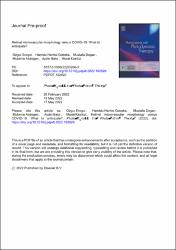| dc.contributor.author | Eroğul, Özgür | |
| dc.contributor.author | Gobeka, Hamidu Hamisi | |
| dc.contributor.author | Doğan, Mustafa | |
| dc.contributor.author | Akdoğan, Müberra | |
| dc.contributor.author | Balcı, Aydın | |
| dc.contributor.author | Kaşıkçı, Murat | |
| dc.date.accessioned | 2022-06-16T08:00:28Z | |
| dc.date.available | 2022-06-16T08:00:28Z | |
| dc.date.issued | 18.05.2022 | en_US |
| dc.identifier.citation | Erogul, O., Gobeka, H. H., Dogan, M., Akdogan, M., Balci, A., & Kasikci, M. (2022). Retinal microvascular morphology versus COVID-19: What to anticipate?. Photodiagnosis and Photodynamic Therapy, 102920. | en_US |
| dc.identifier.issn | 1873-1597 | |
| dc.identifier.uri | https://doi.org/10.1016/j.pdpdt.2022.102920 | |
| dc.identifier.uri | https://hdl.handle.net/20.500.12933/1182 | |
| dc.description.abstract | Background
To investigate retinal microvascular morphological changes in previously COVID-19 infected patients using optical coherence tomography angiography (OCTA), and compare the findings to age- and gender-matched healthy subjects.
Methods
In this cross-sectional study, OCTA findings (6.0 × 6.0 mm scan size and scan quality index ≥7/10) from previously COVID-19 infected patients (group 1, 32 patients, 64 eyes) with ≥1 month of complete recovery were compared to healthy subjects (group 2, 33 subjects, 66 eyes) with no history of COVID-19 infection. A positive real-time reverse transcription-polymerase chain reaction test on a naso-pharyngeal swab sample confirmed the diagnosis. The AngioVueAnalytics, RTVue-XR 2017.1.0.155 software measured and recorded OCTA parameters.
Results
Group 1 had significantly lower superficial capillary plexus vessel densities in all foveal regions than group 2 (P<0.05). Foveal deep capillary plexus vessel density in group 1 was also significantly lower than in group 2 (P=0.009); however, no significant differences were found in other regions (P>0.05). All foveal avascular zone (FAZ) parameters were higher in group 1 than in group 2, with significant differences in FAZ area (P=0.019) and foveal vessel density 300 μm area around FAZ (P=0.035), but not FAZ perimeter (P=0.054). The outer retina and choriocapillaris flows were significantly lower in group 1 than in group 2 (P<0.05).
Conclusions
Prior COVID-19 infection seems to be associated with significant changes in retinal microvascular density, as well as FAZ and flow parameters, which may be attributed to different pathogenic mechanisms that lead to SARS-CoV-2 infection, such as thrombotic microangiopathy and angiotensin-converting enzyme 2 disruption. | en_US |
| dc.language.iso | en | |
| dc.publisher | Elsevier | en_US |
| dc.relation.ispartof | Photodiagnosis and Photodynamic Therapy | |
| dc.rights | info:eu-repo/semantics/openAccess | en_US |
| dc.subject | COVID-19 | en_US |
| dc.subject | Foveal avascular zone | en_US |
| dc.subject | Microvascular morphology | en_US |
| dc.subject | Optical coherence tomography angiography | en_US |
| dc.subject | RetinaVessel density | en_US |
| dc.title | Retinal microvascular morphology versus COVID-19: What to anticipate? | en_US |
| dc.type | Article | |
| dc.identifier.orcid | 0000-0002-0875-1517 | en_US |
| dc.identifier.orcid | 0000-0002-7656-3155 | en_US |
| dc.identifier.orcid | 0000-0001-7237-9847 | en_US |
| dc.identifier.orcid | 0000-0003-4846-6312 | en_US |
| dc.identifier.orcid | 0000000267232418 | en_US |
| dc.department | AFSÜ, Tıp Fakültesi, Cerrahi Tıp Bilimleri Bölümü, Göz Hastalıkları Ana Bilim Dalı | en_US |
| dc.institutionauthor | Eroğul, Özgür | |
| dc.institutionauthor | Gobeka, Hamidu Hamisi | |
| dc.institutionauthor | Doğan, Mustafa | |
| dc.institutionauthor | Akdoğan, Müberra | |
| dc.institutionauthor | Balcı, Aydın | |
| dc.identifier.doi | 10.1016/j.pdpdt.2022.102920 | |
| dc.identifier.startpage | 1 | en_US |
| dc.identifier.endpage | 18 | en_US |
| dc.relation.publicationcategory | Makale - Uluslararası Hakemli Dergi - Kurum Öğretim Elemanı | en_US |
| dc.identifier.pmid | 35597442 | |
| dc.identifier.scopus | 2-s2.0-85132864991 | |
| dc.identifier.scopusquality | Q1 | |
| dc.identifier.wos | WOS:000830903300003 | |
| dc.identifier.wosquality | Q3 | |
| dc.indekslendigikaynak | Web of Science | |
| dc.indekslendigikaynak | Scopus | |
| dc.indekslendigikaynak | PubMed | |
















